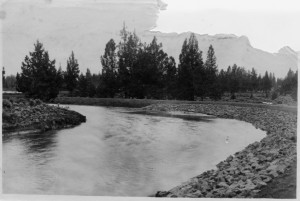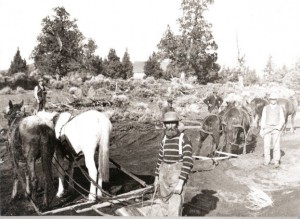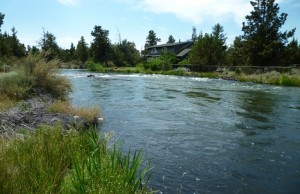
Deschutes Historical Society.)
For over a century, Central Oregon has been graced with open canals lacing across high desert landscapes. Historically the canals were the linchpin that encouraged and fostered settlement of Bend and Redmond. Over time they have become a rich and diverse habitat for plants, birds, and animals. Despite their historic, aesthetic, and ecological significance, the over 700 mile canal system is today under serious threat of being piped in its entirety.
When one of Bend’s founding fathers, Alexander Drake, arrived in Central Oregon around 1900 he quickly saw the potential for an irrigation canal system using water from the Deschutes River to enable agricultural development in the region. He founded a company, Pilot Butte Development Company, drew up plans for the system and with the help of the man who would become Bend’s first mayor, Arthur Goodwillie, secured funding for the project. Beginning in 1902, with the cooperation and hard work of the community, they carved the first gravity-fed canal system into the desert landscape using only black powder, horse-drawn and hand tools.

Deschutes Historical Society.)
In 1905 the City of Bend was incorporated at the nexus of the Deschutes River and Drake’s canal intake. Communities such as Powell Butte (1909), Redmond (1910), and Terrebonne (1910) were subsequently founded because of access to water that the growing canal system could provide. All told, 700 miles of canals were built to allow the settlement of Central Oregon during the first decades of the 20th century. Today, the canal system still largely functions as Drake envisioned, supplying irrigation water throughout Central Oregon.
Beginning in the early 1990s the local irrigation districts began modifying, through lining and piping projects, significant reaches of all of the canals. The oldest remaining canal, Drake’s 1904 Pilot Butte Canal, stretches from Bend to the Crooked River and is maintained and operated by Central Oregon Irrigation District. In 2009, a 2.5-mile section of Pilot Butte Canal north of Bend was piped to reduce water leakage and create hydroelectric power. The Irrigation District is proposing an additional two miles of the canal which runs through neighborhoods on the north side of Bend. Of the entire 700 mile canal system, the section proposed for piping is arguably the most historically significant in all of Central Oregon.

A local citizen group, the Pilot Butte Canal Preservation Alliance, was formed this spring to help redirect efforts to pipe this unique section of Pilot Butte Canal. Because the segment proposed for piping winds through a residential neighborhood where the canal’s historical integrity—signs of the original hand-tool construction—remain evident in its basalt bed, in recent months local property owners have rallied against the Central Oregon Irrigation District at public hearings. Despite the rapid planning process, the Pilot Butte Canal Preservation Alliance believes that “preservation is still possible.”

In April, affected property owners attempted to nominate the one-mile section of Pilot Butte Canal as both a City and County Landmark. In 1994, a number of canals were recognized as eligible for historic designation—including Pilot Butte—though they were never formally designated. Because of Central Oregon Irrigation’s District’s objection to designation, neither the City nor the County would accept the nominations for consideration.
In the Bend Area General Plan, the section of Pilot Butte Canal was identified for preservation for aesthetic and recreational purposes, such as a hiking and biking trail along its banks. Recently, LUBA and the Deschutes County Planning Commission issued findings against the proposed piping project, but the issue now lies in front of the Board of County Commissioners. The Pilot Butte Canal Preservation Alliance is committed to finding a solution that keeps the canal open for generations to come.

